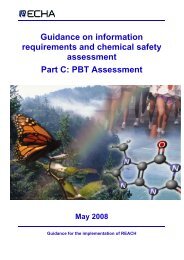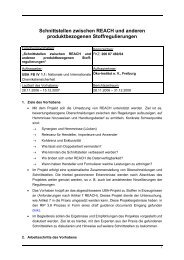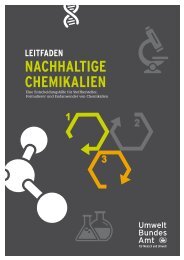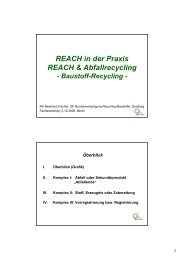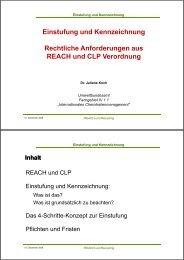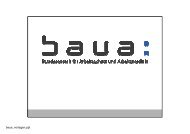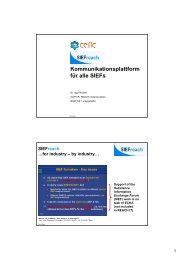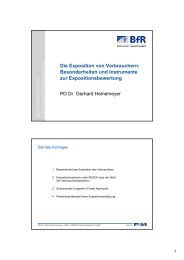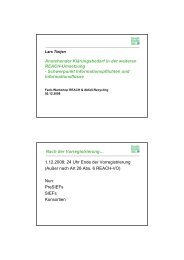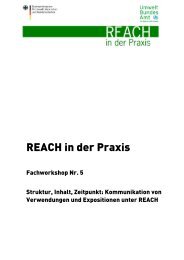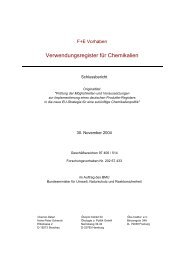“EU-Workshop on Socio-Economic Analysis under REACH ...
“EU-Workshop on Socio-Economic Analysis under REACH ...
“EU-Workshop on Socio-Economic Analysis under REACH ...
Create successful ePaper yourself
Turn your PDF publications into a flip-book with our unique Google optimized e-Paper software.
3. Technical Guidance Document <strong>on</strong> carrying out a SEA <strong>under</strong> <strong>REACH</strong>: Report<br />
<strong>on</strong> preliminary study – RIP 3.9-1 by Meg Postle, Risk and Policy Analysts<br />
(RPA), United Kingdom<br />
The presentati<strong>on</strong> outlines the objective and approach of the study and the structure<br />
of the Final Report. It illustrates that the study is aimed at providing a preliminary<br />
report investigating the current state of the art c<strong>on</strong>cerning the applicati<strong>on</strong> of socioec<strong>on</strong>omic<br />
analysis (SEA) to chemical risk management and the need of guidance for<br />
different stakeholders when developing either a SEA or inputs to <strong>on</strong>e during the<br />
<strong>REACH</strong> authorisati<strong>on</strong> and restricti<strong>on</strong>s procedures. The study identifies and reviews<br />
the relevant background <strong>on</strong> the use of SEA in chemical risk management,<br />
establishes the state of the art in SEA applied to chemical risk management,<br />
analyses the decisi<strong>on</strong> chains and the requirements for SEA <strong>under</strong> the authorisati<strong>on</strong><br />
and restricti<strong>on</strong>s processes, reviews presentati<strong>on</strong>al formats and methods, identifies<br />
what types of software tools may be of value and develops case studies. The Final<br />
Report c<strong>on</strong>tains illustrative frameworks for the Guidance based <strong>on</strong> ‘best practice’<br />
(Part A), supporting informati<strong>on</strong> <strong>on</strong> impact assessment (Part B) as well as<br />
c<strong>on</strong>sultati<strong>on</strong>, case studies and checklists (Annexes). In her c<strong>on</strong>clusi<strong>on</strong>s and<br />
recommendati<strong>on</strong>s, Meg Postle <strong>under</strong>lines the importance of flexibility in the Technical<br />
Guidance Document: There are different users such as large and small companies<br />
and third parties. They will make use of the Guidance in different manners.<br />
Furthermore, up-dates and new developments in SEA and other relevant<br />
assessment practices will have to be included in the Guidance. The presentati<strong>on</strong> also<br />
recommends proporti<strong>on</strong>ality of a SEA. It outlines that the guidance should stress<br />
areas where specific expertise may be required. It also describes what is expected of<br />
the Guidance, e.g. accessibility to all users, details of the criteria according to which<br />
SEA may be assessed, as well as software tools.<br />
4. Technical Guidance Document <strong>on</strong> carrying out a SEA <strong>under</strong> <strong>REACH</strong>: Report<br />
<strong>on</strong> the status of the subsequent project – RIP 3.9.-2 by Michael Sorensen,<br />
Entec UK, Ltd., United Kingdom<br />
In his presentati<strong>on</strong>, Michael Sorensen describes the objectives, working plan, status<br />
and preliminary findings of RIP 3.9.-2. The key objective is to develop the (draft) final<br />
17 17



